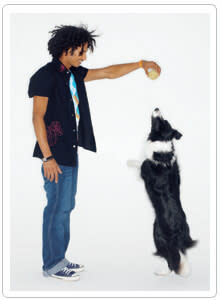
We love our dogs and want only the best for them, but sometimes we go too far and become over indulgent with our four legged companions - blurring the lines of our relationship. Most owners understand that they have to be their dog’s leader, but how to be a good leader is often misunderstood. Being a good leader does not mean that you have to be physical with your dog. Being a good leader for your dog is much like being a good boss to your employees or a good parent to your children. Good leaders are confident, consistent and fair.
If your dog gets on the furniture and then growls when you try to remove him, if he barks or nudges your hand incessantly until you give him attention or if he regularly refuses to come when called, you need to re-establish the relationship with your dog.
The following will provide you with non-confrontational and effective techniques that your whole family can take part in to set boundaries with your dog. If your dog has bitten you or other family members, please seek the help of a professional canine behavior consultant that can start you on a behavior modification program.
How to practice being a good Leader
Owners must learn that they control their dog’s access to any and all of life’s goodies. From now on, request that your dog sit or lie down before gaining access to what he wants. This does not mean that you have to ignore your dog or be aloof with him, give as much love and attention as you want, but do so on your terms, not his. Good leaders know when to compromise.
You will have to be more persistent than your dog and know that he may not respond immediately. If he refuses to perform the cue, walk away and come back a few minutes later to give him another chance.
The benefits of this technique
Most dogs assume a neutral or submissive role toward people, but some have learned that they can get by with inappropriate behavior by challenging their owners. Requiring these dogs, especially during adolescence to work for everything they want and need is a safe and non-confrontational way to establish control and motivate your dog to want to respond to you.
Just because your dog is not showing signs of aggressive behavior i.e. growling or snapping does not mean that he hasn’t learned how to control access to resources in inappropriate ways. These dogs may display affection through “pushy” behavior, such as nudging your hand to be petted. This technique gently reminds the “pushy” dog that it must abide by your rules.
Make unacceptable chew items unpleasant to your puppy. Furniture and other items can be coated with Bitter Apple™ to make them unappealing. Some dogs don’t mind the taste of Bitter Apple™ and you may have to try another taste deterrent.
Children are often viewed differently by the dog. They are playmates and toys, but there is no respect. Children are more frequently “corrected” for inappropriate behavior than adults. Having your children practice these techniques can establish a healthy relationship between them and the family dog.
Other Tips for being a good leader
Instead of using your hands to push your dog down, use your body to block him from moving into your space. Practice restraining your dog and handling his feet, mouth, ears – for a food treat.
Practice basic obedience cues multiple times per day for one minute increments. Use the cues you teach your dog during daily interactions i.e. sit-stay when visitors arrive.
You begin and end play sessions. Keep games short and sweet so your dog wants to continue playing with you.